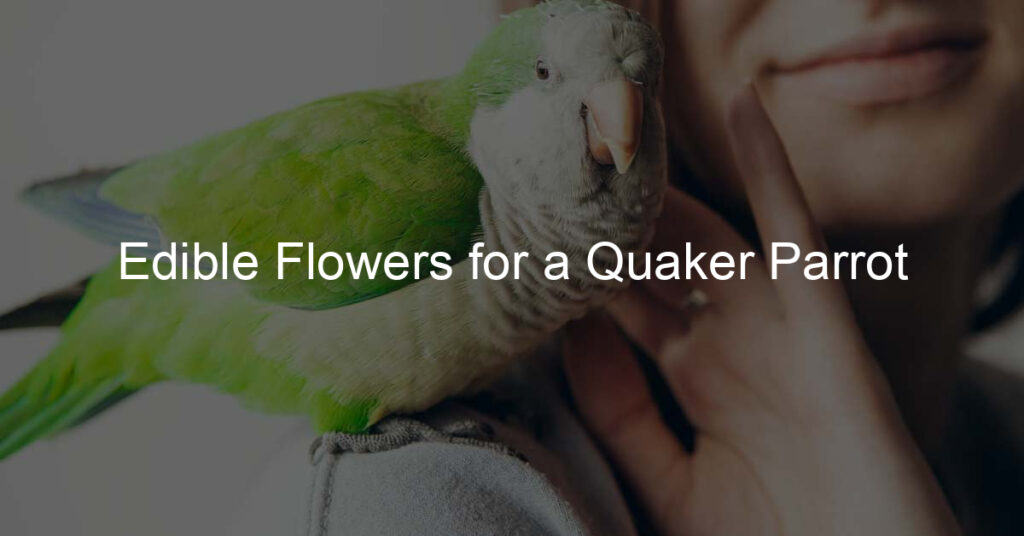What do you get when you mix a little bit of creativity with your love for your feathered friend?
The perfect way to show them how much you care is – edible flowers!
Introducing a variety of different colors, flavors, and textures into their diet is not only fun but also beneficial to their health. Here are some of our favorite edible flowers for the Quaker parrot in your life!
What are birds’ favorite flowers?
Birds love to forage for their favorite flowers in an array of varieties, from daisies and marigolds to geraniums and petunias. Depending on the species, some birds such as pelicans, quails, and hummingbirds favor nectar-rich blossoms while others prefer wildflowers rich in seeds.
Sunflowers remain a favorite amongst all types of birds due to their high oil content.
While countless flowers may naturally attract birds, including pansies and other hybrid blooms, creating a garden designed with their preferences in mind is the best way to guarantee that you’ll see flocks of feathery friends taking refuge around your home.
Why do parrots eat flowers?
Parrots have a diet that consists mostly of fruit, nuts, and seeds. However, they also like to eat flowers from time to time. The question is why? Interestingly enough, flower petals contain high levels of natural antioxidants which are beneficial for their health.
Furthermore, the petals themselves provide Vitamin A and many other helpful vitamins for them as well.
In addition to these vitamins and minerals, parrots may also be attracted to the colors and shapes of flowers. All in all, parrots eating flowers serve a nutritional purpose alongside their inherent aesthetic appeal.
Which flower is safe for parrots?
Decorating your parrot’s habitat with flowers can spruce up the place, but it’s important to make sure you choose a flower that is safe for your feathered friends. Bird-safe blooms include hibiscus, chrysanthemum, and impatiens.
While some plants such as lilies and foxglove are beautiful, they can be toxic to birds if ingested so it is best to avoid them when selecting flowers for your parrot’s habitat.
With these selections in mind, you will be able to find a variety of bloomin’ bouquets that will work perfectly as decorations or snacks!
Are any flowers poisonous to birds?
Most flowers may look beautiful and harmless, but some varieties can be hazardous to birds. For instance, oleander is a common sight in many yards and gardens, but this gorgeous flower has toxic substances that can lead to cardiac arrest if ingested by birds.
The sap of lilies, foxgloves, buttercups, monkshood, and daffodils are all known to be poisonous as well and should be avoided in bird-safe gardens.
Additionally, Easter and autumn crocus commonly used in holiday decorations can also be deadly for birds. While these dangerous plants need to be kept away from our feathered friends, the majority of flowers are perfectly safe for them;
so don’t forget to enjoy the beauty of blooms with your beloved birds!
Do birds eat fruit and flowers?
It may come as no surprise that birds are very fond of fruit and can often be seen pecking away at juicy berries found in nature. But, do you know if they also eat flower petals from plants?
The answer is yes; more specifically, birds will peck at the petals of certain fruits such as apple and raspberry flowers. In addition to picking apart the petals for sustenance, these birds also feed on any pollen grains and even nectar located within the flower.
While most birds don’t specialize in eating fruit flowers, certain breeds do demonstrate a passion for them;
among these are hawfinches, grosbeaks, and waxwings which often frequent fruiting shrubs in search of ripe berries. So, while it may not typically be something they prioritize, birds certainly can and do enjoy feasting on a variety of edible fruit flowers.
The Bottom Line: Edible Flowers for a Quaker Parrot
All in all, edible flowers for a Quaker parrot can be a great way to add some variety and nutrition to your bird’s diet. Never forget to research which ones are safe before feeding them to your feathered friend.
Adding just a few of the safest varieties to their meal plan can provide endless benefits and provide plenty of variety from the bird’s usual diet.
Not only will this create an exciting new texture in their eating habits but can also help boost immunity and even help keep illness at bay. As with any venture into unknown nutrition for a parrot owner, always consult with an avian veterinarian before making changes.
Furthermore, do not introduce too many new flavors or items too quickly as this could potentially upset their digestive system or finicky eating habits. Edible flowers can certainly be an excellent addition when treated wisely added.








